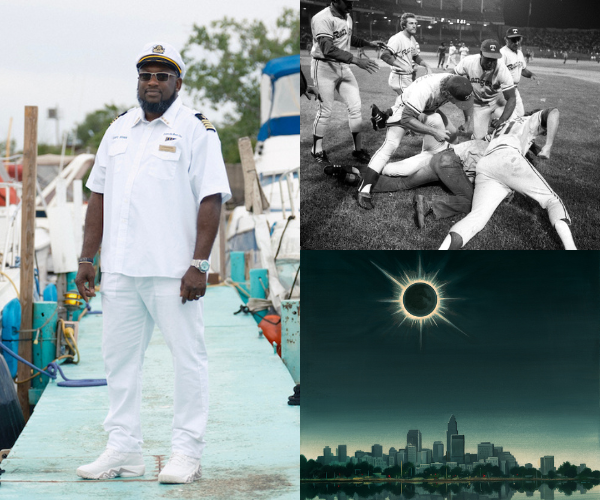Reporter's Requiem
by Michael D. Roberts | Apr. 19, 2013 | 4:00 AM
It was Whelan's "o" that bothered me. He'd hit that typewriter key so hard, driving the letter so deep into the paper, it left a hole rather than an "o." Every time I edited his articles, my pencil would catch in a hole and tear the page. His copy looked more like a target than a story.
But the real target was always the substance of Edward P. "Ned" Whelan's stories. His articles in this magazine in the '70s and '80s upset legions of public officials with tales of their feckless follies. Organized crime subscribed to his work because he chronicled their activities with an eye toward history.
Whelan ate catfish with city council president George Forbes, arguing the merits of city politics. He exposed Mayor Ralph J. Perk's purchase of an elegant toilet and beat the bank examiners to financial scams.
Sadly, Whelan died on March 20, following an accidental fall at his daughter's home in Phoenix. He was 70. He would have liked that one obituary called him a legendary journalist, which he was.
Whelan and I came to Cleveland Magazine because The Plain Dealer had become a mess by 1972. The social conflicts of the time — Vietnam, Kent State and civil rights — had exposed a generation gap, dividing the editorial staff and management. Important stories were going uncovered because editors deemed them out of society's mainstream. Though Whelan's remarkable reporting from City Hall was a constant threat to the competing Cleveland Press, he got caught up in the generational turmoil.
The woes at The Plain Dealer finally led us to the musty upstairs rooms of the Emerson Press, where Lute Harmon Sr., an advertising copywriter at the Cleveland Electric Illuminating Co., was busy starting a city magazine. Not many gave it a chance of success.
Yet for the next 14 years, Whelan proceeded to become the town's dominant journalist and helped secure the magazine's place in the city.
Whelan told Cleveland's unfolding story like never before. He understood its good and its bad and wrote of its ugliness and its penchant for distorting the truth. He knew everyone, from the homicide squad to the corporate lawyers in the lofty firms to the sporting crowd that occupied the legendary Table 14 at the old Pewter Mug. His work, a careful accounting of contemporary history, will be as important to scholars in future years as it was to magazine readers.
The last time I saw George Steinbrenner, before his death in 2010, he asked about Ned. "I'm glad he's not in New York," Steinbrenner said. "The media is bad enough, and he would only make it worse."
By "worse," he meant more tenacious. Whelan had once put Steinbrenner through a grueling 10-hour interview about his role in the Watergate scandal (he was convicted in 1974 of giving illegal campaign funds to President Nixon). Steinbrenner even sent out for food.
When Dick Jacobs bought the Cleveland Indians in the late '80s, he was largely unknown. He refused interviews and remained aloof. Whelan ran into him at the bar at Sammy's and asked for an interview. Jacobs declined, whereupon Whelan said he could write the story without talking to him, since he already knew Jacobs' net worth.
Jacobs was startled when Whelan named the correct figure. So was Whelan. He had pulled the number out of the air.
Whelan often wrote of organized crime, feeding the city's fascination with the mob. When the FBI apprehended the killer of the infamous gangster Danny Greene, they found that he had used a picture in a copy of Cleveland Magazine, accompanying an article of Whelan's, to identify the victim.
One of Whelan's sources tipped him off that the mob was trying to take over a major bank downtown. He wrote a cover story revealing the plot. There was only one problem. The unsuspecting president of the bank was one of the magazine's investors.
The angry bank president summoned me and Lute Harmon for a damning confrontation regarding Whelan. In the midst of the tirade, Harmon held up his hand and said the fair thing to do was to buy the investor's stock, which we did, with a burdensome bank loan. Harmon later said absolutely nothing would stop Whelan from getting a story.
Once, Whelan called me from Henry Ford II's house in Detroit.
"I'm at Henry's, having lunch with his wife," he said.
"Henry who?" I asked.
"Ford, as in the car," Whelan responded, off on yet another story.
Not only was Whelan's reporting acknowledged locally, Harvard University's Nieman Reports selected Cleveland Magazine in 1980 as one of the top city magazines in the nation. The report called it "a gritty magazine in a town widely known for its gritty reality." Whelan supplied much of the grittiness.
Then in 1987, after 14 years of deadlines that seemed to fall like dominoes, Ned quit the magazine to open a public relations business. He had a family and wanted to make money. Journalism demands a vow of poverty and the pace is wearing.
His friends saw dramatic changes in him. He stopped drinking, sought memberships in the Union and Tavern clubs, and joined civic boards. He adopted conservative political leanings and absorbed all of our chiding over this metamorphosis.
A few days before his death, we had lunch at Nighttown with The Plain Dealer's Brent Larkin, an adversary during our newspaper days. We were talking about November's Cleveland police shooting, in which 137 shots were fired and two people killed.
"What a story that would have been for the magazine," Whelan said. "Can you imagine what we would have done with that?"
With Ned, I didn't imagine, I knew. Just like I know he is simply between deadlines now.
Trending
-
1
-
2
-
3
-
4
-
5










